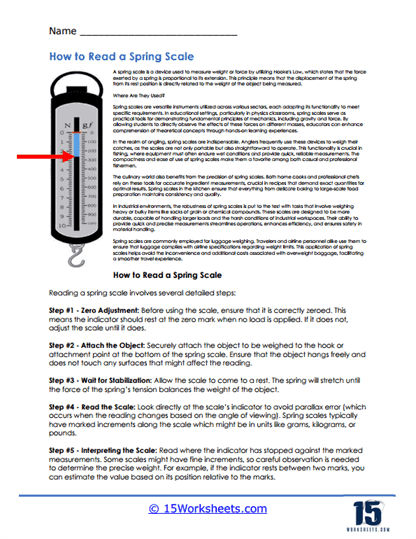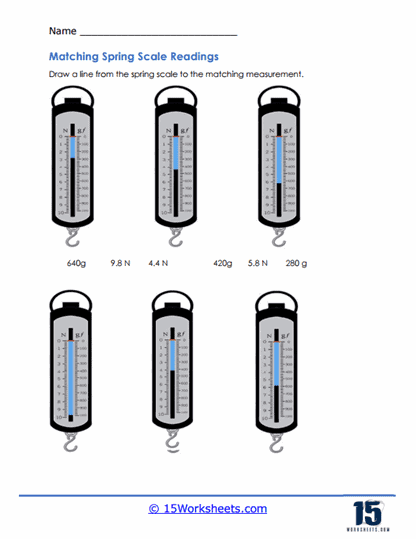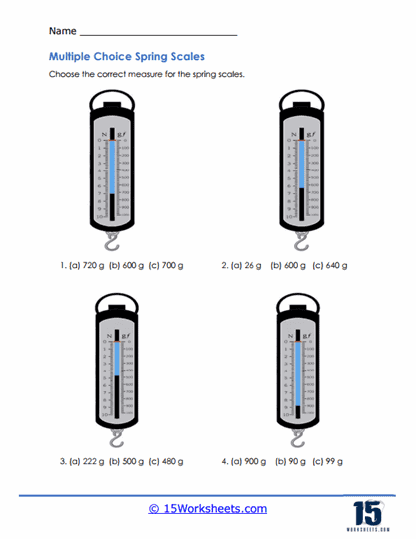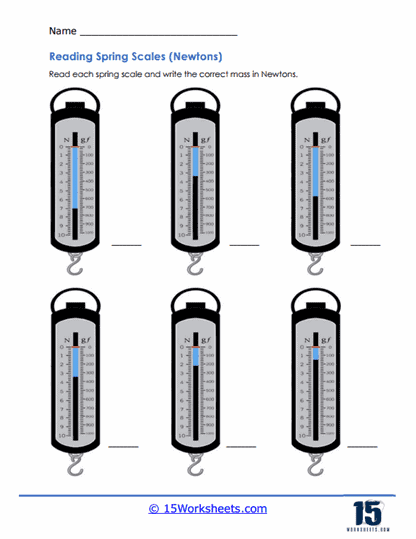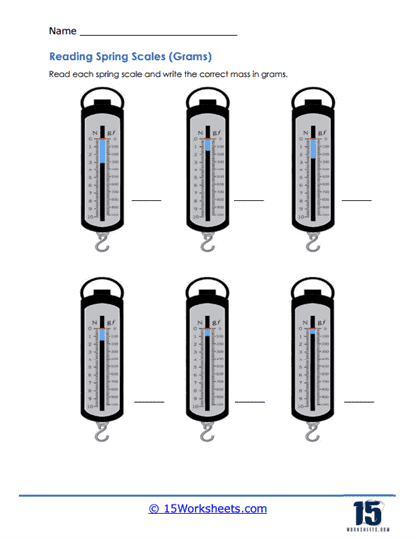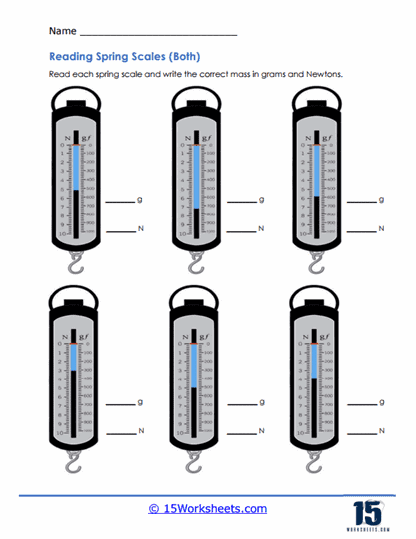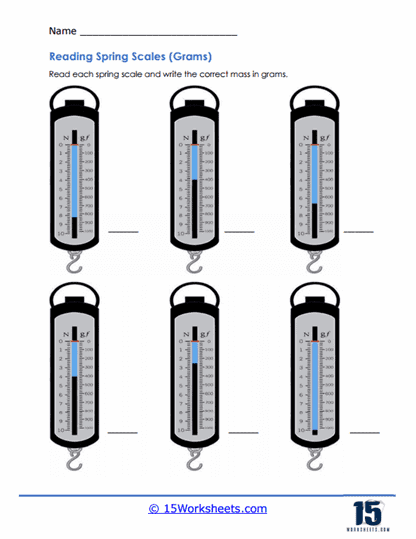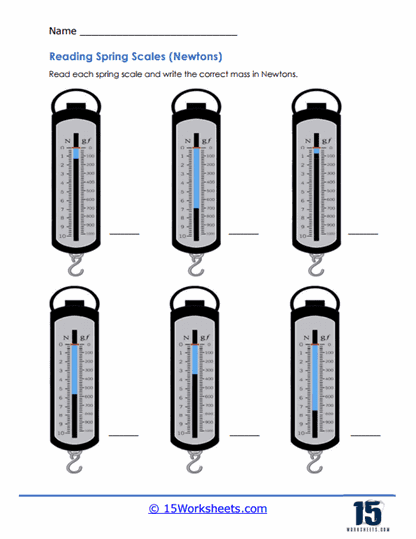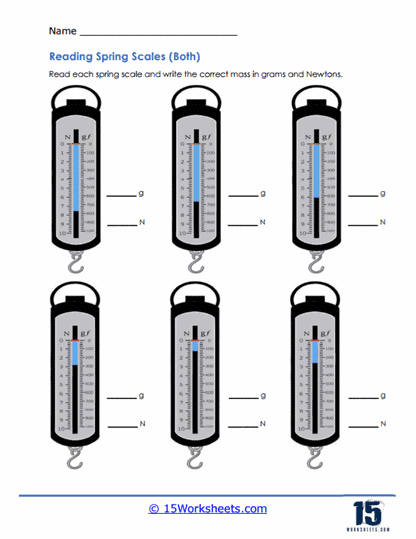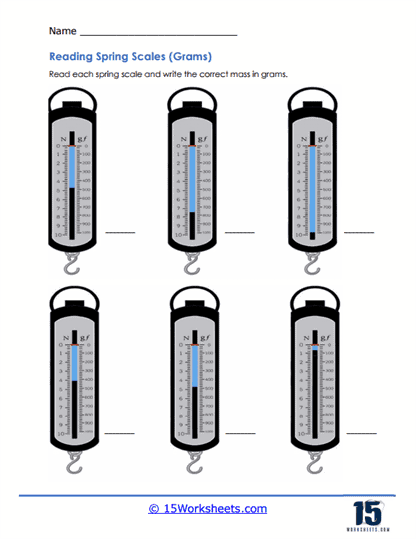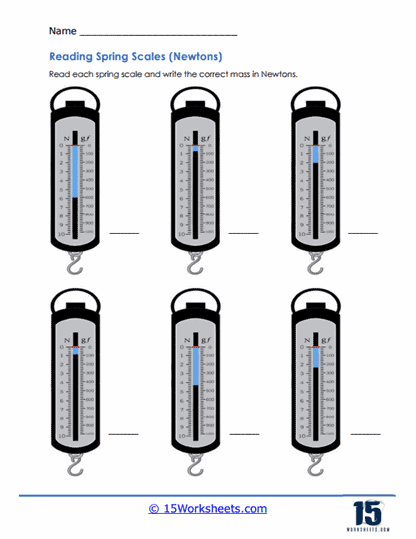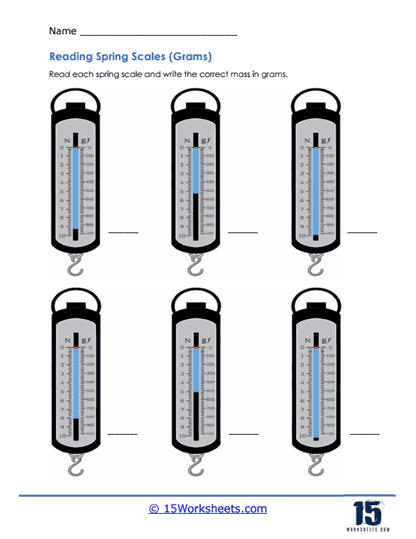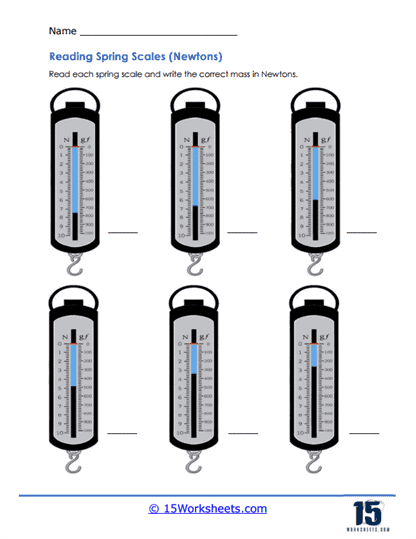Reading Spring Scales Worksheets
About These 15 Worksheets
These worksheets will help students better understand how to measure force and weight using a spring scale. These worksheets play a critical role in teaching concepts of measurement in physics and general science classes at elementary and middle school levels. A spring scale, often used in educational settings, measures weight by the tension of a spring; it converts the displacement of the spring into a measurement of weight on a scale. These worksheets include a variety of exercises that help students apply their knowledge of how spring scales work, interpret scale readings, and understand the relationship between force, gravity, and mass.
Through a range of exercises from basic scale reading to complex problem-solving and experimentation, these worksheets prepare students for further studies in physics, engineering, and other sciences. They help students develop a comprehensive understanding of how different forces interact in the physical world, fostering a deeper appreciation for the principles of physics and measurement.
Types of Exercises
Identification of Parts and Their Functions – Early exercises on these worksheets typically involve identifying different parts of a spring scale, such as the spring itself, the hook, the dial, or the pointer. Students learn what each part does and how they all work together to measure weight. This foundational knowledge is crucial for understanding how measurements are taken and ensures that students can handle a spring scale correctly.
Reading the Scale – Exercises require students to read the measurement shown on a diagram of a spring scale. These diagrams depict the scale with various weights, and students must determine the weight based on the position of the pointer. This type of exercise helps students practice interpreting the divisions on the scale, often necessitating conversions between different units of measurement, such as grams and kilograms.
Estimation Before Measuring – To develop a sense of approximation, some worksheets ask students to estimate the weight of an object before actually measuring it using the spring scale. This method enhances students’ ability to gauge weight visually and contextually, providing a practical skill that bolsters their measuring accuracy.
Comparative Measurements – These activities involve using a spring scale to compare the weights of two or more objects. Students may be asked to predict which object will be heavier or lighter and then use the scale to verify their hypotheses. This type of exercise not only aids in understanding the concept of gravitational pull on different masses but also introduces basic scientific method skills such as hypothesis testing and experimental verification.
In more advanced worksheets, students might be asked to take multiple readings of the same object to calculate the mean weight. This exercise teaches students about the variability and reliability of measurements and introduces them to basic statistical concepts like averages, which are important for handling real-world data.
Some worksheets include exercises where students must weigh multiple items and plot the weights on a graph. This helps students make visual comparisons between weights and introduces them to graph reading, a skill that is essential across various scientific disciplines.
Problem Solving – These exercises present real-life scenarios where students need to solve problems using a spring scale. For example, students might need to determine if a suitcase is over an airline’s weight limit or calculate the total weight they can carry on a hiking trip. This applies their theoretical knowledge in practical, everyday situations, enhancing learning retention.
What Are Spring Scales?
Spring scales are measuring instruments used to determine the weight or force exerted by an object. These scales operate on the principle of Hooke’s Law, which states that the force exerted by a spring is directly proportional to the distance it is stretched. Essentially, a spring scale measures the weight of an object by the amount of stretch or compression of a spring inside the scale.
Components and Design
A typical spring scale consists of a spring fixed at one end with a hook to attach the object at the other. The spring is enclosed in a cylindrical tube that often has a scale printed on it to read the weight directly. When an object is hung on the hook, the spring stretches, and the extent of this stretch indicates the weight of the object.
Uses of Spring Scales
Spring scales are versatile tools utilized in a variety of real-world applications across multiple industries due to their simplicity, portability, and the direct measurement they provide. One common use of spring scales is in educational settings, where they serve as practical instruments for teaching the principles of physics, particularly Hooke’s Law which relates to the extension or compression of a spring in proportion to the force applied to it. This makes them ideal for classroom demonstrations where students can visually grasp the effects of varying weights on the spring’s tension. Furthermore, they are employed in science labs for experiments that involve measuring force or comparing the density and gravitational effects on different objects.
In commercial and professional domains, spring scales have significant utility. They are widely used in the food industry, especially in kitchens and markets for weighing ingredients and produce accurately. This is crucial not only for culinary precision but also for maintaining consistent product standards and managing inventory. Fishermen also rely on spring scales to weigh their catch effectively, ensuring compliance with regulations and proper market pricing. Moreover, these scales are common in the shipping industry to determine the weight of packages, thereby aiding in logistics planning and the distribution process to ensure that loads are appropriately managed without exceeding transport capacities.
Spring scales are invaluable in various fieldwork scenarios, particularly in environmental science and geography where researchers measure soil erosion or the mass of rock samples in situ. They are also used in the construction industry to measure the tension in cables and other support structures, ensuring safety and structural integrity. Travelers frequently use portable spring scales to weigh their luggage to avoid airline overage fees. These diverse applications highlight the scale’s practicality, reinforcing its importance across a spectrum of everyday activities and professional tasks, proving that despite their simplicity, spring scales are essential tools in both mundane and specialized tasks.
How to Use a Spring Scale
Using a spring scale involves several straightforward steps:
Step #1 – Calibration – Before using the scale for precise measurements, ensure it is calibrated to zero. Some scales have a manual calibration dial to adjust the pointer to zero.
Step #2 – Attaching the Item – Attach the item to be weighed to the hook at the bottom of the scale. Ensure that the item is securely fastened and hangs freely without touching any surfaces.
Step #3 – Reading the Scale – Once the item is attached, the spring will stretch. Wait until the spring stops moving and settles into its final stretched position. Read the measurement directly from the scale where the indicator or the pointer aligns. The scale may show weight in various units such as grams, kilograms, pounds, or newtons.
Step #4 – Interpreting Results – Interpret the results based on the unit of measure. If your readings require further calculations (for example, converting grams to kilograms), perform these calculations after recording the raw data from the scale.
Step #5 – Resetting the Scale – After removing the item, ensure the scale returns to its zero point. If it does not, recalibrate the scale for accuracy.
Tips for Accurate Measurement
– Ensure the spring scale is vertical during measurements to avoid parallax errors.
– Avoid overloading the scale beyond its maximum capacity, which can permanently stretch the spring and lead to inaccuracies.
– Use the scale in an environment with minimal vibrations and air movements, as these can affect the stability of the item being weighed and lead to fluctuating readings.

